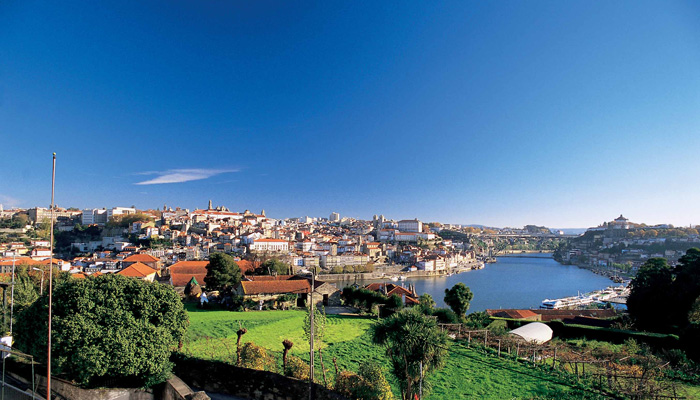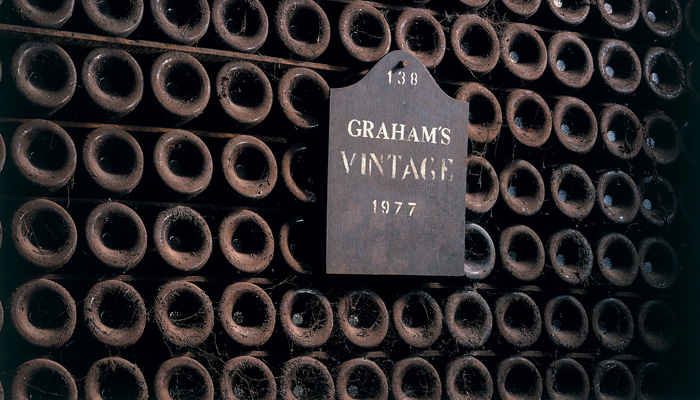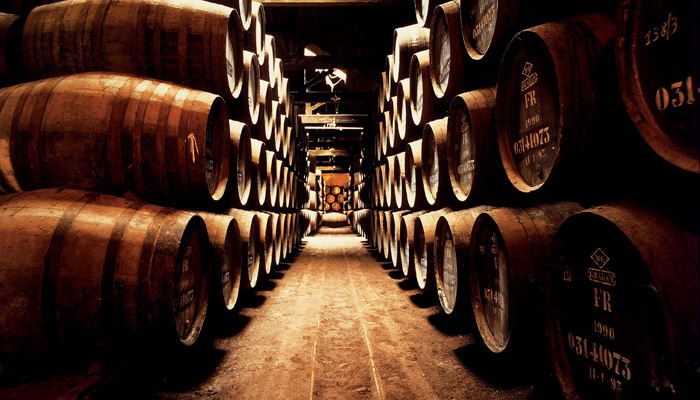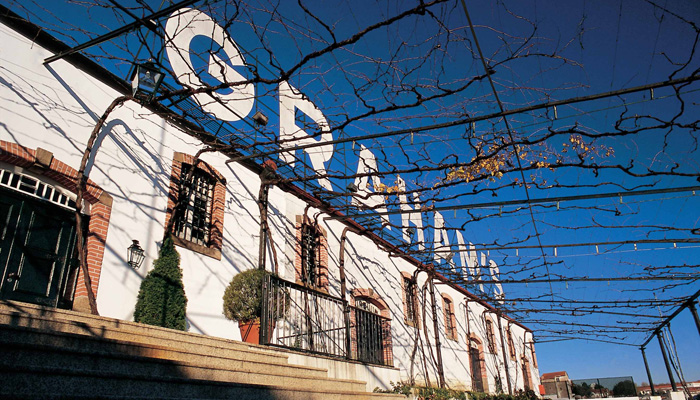A Trip Up the Douro
Author: Berry Bros. & Rudd
Arriving at Oporto airport, the luscious green landscape belies the fact that in summer this is the hottest wine growing area of Europe. Not wanting to miss the England versus Wales, we watched the rugby at the house of Johnny and Helen Symington before driving to the hotel to change for dinner at The Factory House. The Factory house was originally built by the British Port wine shippers as a type of gentleman’s club to discuss their business. Today the members represented are still all British-owned Port companies and they still meet on a Wednesday for lunch, to discuss business and participate in a blind tasting. After a sumptuous dinner, we were totally surprised as the side doors of the dining room opened to an identical twin dining room used solely for the enjoyment of vintage port. Graham’s 1952 Diamond Jubilee Colheita was served alongside 1970 Graham’s vintage port with plates of dried apricots and walnuts. The evening was not complete without a toast to the Queen and the President of Portugal as well as the stories of the Bishop of Norwich. Port is traditionally passed to the left, but when a guest has forgotten to pass the port their attention is called by the question “Do you know the Bishop of Norwich?” Those who are not acquainted with the tradition will be told that he is ‘a good chap, but never passes the Port’. Intriguingly, the current Bishop of Norwich is called Graham…
Oporto is the second largest city of Portugal and can trace its history back to the 4th century. As the morning sun comes up over the city, it shows a mosaic of coloured houses and the signs of the famous port lodges, where almost all ports are still aged. For the first two days we are in the hands of the Symingtons, whose portfolio include Graham’s, Dow’s, Warre, Cockburn, Quinta do Vesuvio and Smith Woodhouse. The Symingtons have been port producers since 1882 and today the business is run by five members of the family. It is the only major port company to be wholly family owned and the Symingtons are the largest vineyards holders with 26 quintas. Each of the properties has their own styles, and character – we hear more about each over the next 24 hours. We visited first the Graham’s lodge in Vila Nova de Gaia. Recently restored it is worth visiting for the sense of history, to understand the ageing process and finally to eat in their newly built restaurants. Johnny Symington with winemaker Henry Shotton showed us their 2011s. Rainfall at the end of 2010 had topped up the water-reserves, critical to the vine’s sustenance during the hot summer months. A hot, humid April and May caused some oidium and mildew in the vineyards, which affected the final yields rather than the quality of the fruit. The summer months were extremely hot and dry culminating in small thick skinned berries with high sugar levels. An extra-ordinary blessing came in the form of rain on the 21st August and 1st September, which softened the skins (important due to the short maceration and fermentation of port) and allowed the phenolic (flavour) ripeness to catch up. The 2011s are characterized by deep dark fruit, real precision and a continuous length. Production for the 2011s is low with the average production down by 25-30% on that of the 2007s (and about 45% down on the 1994s). As a result, the Symingtons expect that the full production will be sold en primeur and they are not intending to hold stock back (apart for personal use) at the estates.
After the tasting, we drive inland to Quinta do Vesuvio, which is located in the Upper Douro about 30 miles from the Spanish border. From Oporto we first cross the Serra do Marao, a 1000m high mountain range that protects the vineyards from the rains arriving from the sea. The views are spectacular, but the drive shows just how inhospitable the terrain is. It seems madness that anyone could have thought that these steep, stony, mountains in some of the most remote country in Europe with a climate that hits 40°C in summer could be a good place to build vineyards. After almost three hours we park the car and cross the Douro river by boat to arrive at Quinta do Vesuvio. Vesuvio was originally founded by Don Antonia, a formidable woman who did not simply build a winery in one of the most remote parts of the Douro, but had sufficient vision to build a large scale lagare system envisioning growth as well as completely self-sufficient communities including a school for the children. It is so hot in this part of the Douro that the vineyards are north facing. Quinta do Vesuvio was added to the Symington portfolio in 1989 and has preserved all the traditions of the Port industry, while maintaining the highest quality port production; harvest takes about five weeks with a team of 40 pickers who pick from 7am to 5pm and after dinner spend four hours manually treading the grapes in the stone lagares. We first visited the winery with a short tasting of the 1994, 1996 and 2003 Quinta do Vesuvio. Followed by a drive to the top of the mountain to see the whole of the estate, drink white port & tonic and give Johnny the time to explain more about the domaine; there is a program of constant replanting to ensure a good supply of old vines at all times, there is an experimental vineyard since 1997 (3ha at Warre’s Cavadinha’s vineyard), the Symingtons own the largest organic vineyard in Portugal and employ 7 full time coopers to ensure their barrels are in perfect condition. To continue the traditional theme at Vesuvio we eat a harvest lunch of grass soup and Bacalhau (dried salted cod). Back across the Douro by boat, we drive across the windy roads to Quinta dos Malvedos, the major Quinta for Graham’s. The house is surrounded by walled terraces of vines, which form the heart of Graham’s Stone Terraces vintage port. The steep slopes are almost impossible for machines and once again we are stunned by the remoteness of the landscape and its beauty. I have visited quite a few wine-regions but have never seen such a beautiful landscape. It is not surprising that the Douro valley is classified as a world heritage by UNESCO.
We continue to enjoy the wonderful hospitality from Helen and Johnny Symington as we stay the night at Malvedos. Dinner is served with 1963 Graham’s, 1977 Warre and 1980 Dow’s (still so young) as conversation flows easily. We talk about the balancing of old traditions and innovation, the search for the best quality and the importance of upholding family values. The next morning we look at the robotic lagares that the Symingtons themselves designed. It brings great advantages in the sense that it is temperature controlled and it is quicker to get the juice from the fermentation vat to the fortified spirit therefore allowing an extra precious hour of extraction. Overlooking the Douro we taste the 1978, 1986 and 1999 Graham’s Quinta dos Malvedos. As Johnny Symington said ‘1986 was the vintage that never was’. Everyone had declared the 1985 and therefore the 1986 is the forgotten vintage, but the cool fruit, dark intensity and rich texture of the 1986 shows that it may be worth declaring two vintages in a row. It is time to say goodbye to our wonderful hosts as we board a boat to take us to Pinhão. The breathtaking views of the Douro are best admired by boat and it is by far the easiest mode of travel.
Pinhão, located in the Cima Courgo (middle Douro) seems like a metropolis after the remoteness of the last two days. It is 10 minutes from Pinhão to the exquisite Quinta do Noval, where we are met by Christian Seely, managing director of AXA Millesimes. Christian has a special affection for this estate, as it fulfilled a long standing dream of running a winery when he was offered the position of running the estate in 1993 on behalf of AXA Millesimes. Christian feels that Noval of all the major port houses is ‘most strongly identified with a sense of place’ as it is the only major port house associated with one single port. In addition, Quinta do Noval Nacional is the ultimate expression of a single (2ha) quinta. We started with a slightly bizarre, though fascinating, line up of ports; from Noval Black to 2003 Noval Nacional. A walk after lunch through the vineyards just re-enforced how beautiful this property is. The 2ha Nacional vineyard lies at both sides of the driveway and I had never grasped just how small the vineyard is. The vines are famously ungrafted as the soil for mysterious reasons is free from phylloxera. The average age of the vines is 30 years and they are incredibly low yielding with many vines only producing one bunch. A great example of terroir, the port is made in exactly the same way as the Noval Vintage port, but produces a port that is totally different in style, so much so that in 1996 Noval declared the Nacional but not the Noval Vintage and in 2003 they only produced the vintage but not the Nacional.
We enjoyed a magnificent dinner with a traditional leitão assado (suckling pig) and dry Douro reds followed by 1968 Colheita, 1967 Noval Nacional, 1980 Noval Nacional (sadly corked), and 1937 Colheita. The latter was tremendous, with the edge taking on an olive green tinge and a length that simple went on and on.
After a boat trip on the Douro on Tuesday morning we travelled by car to Quinta do Panascal for lunch and a visit to the vineyards at Quinta da Roeda with viticulturist António Magalhães. For anyone passionate about the production of wine, this was a fascinating tour. We looked at the advantage of vertical plantings rather than terraces and the importance of the different grape varieties to the final blend. 25% of all the grapes used at Taylor’s, Fonseca and Croft are from their own supply (and 100% for their vintage ports) adding to the control that they have over the final quality of their wines. After the vineyard visit we went to see one of the warehouses. Increasingly the Taylor Fladgate Partnership stores and ages their ports in the Douro rather than making the journey to Vila Nova de Gaia and as today this is possible with temperature and humidity controlled warehouses. Our last night in the Douro we stayed at Quinta de Vargellas with Adrian Bridge as genial host. As the main road towards Vargellas was covered by a landslide (erosion is still a major problem in the Douro), we took a steep windy path covered in potholes but with fantastic views over the Vargellas vineyards. Vargellas is located within an amphitheatre of terraced vines and from the house one looks out on part of the vineyards that form the core of the Vargellas Vinha Velha (80-100 year old vines, which in outstanding vintages produce an outstanding special cuvée). That evening we tasted the 2000 Vargellas Vinha Velha with it beautifully scented fruit. After dinner we did a parallel tasting of the 1985 Fonseca and 1985 Taylor’s, opened with tongs heated on the fire. The 1985 Fonseca was intense giving an explosion of flavours on the palate, but personally I prefer the slightly more restrained Taylor’s at this stage.
Wednesday morning after breakfast, we tried to hit a few golfballs over the Douro river (unsuccessfully) before returning to Oporto to visit the Taylor’s lodges for one of the most fascinating tastings of the trip; a 2011 component part tastings with David Guimaraens. We tasted 3 wines from three different quintas, followed by three samples from vineyards planted in 1970-1980s (less old than samples 1-3 and therefore with less varieties), followed by two samples from the same vineyard, but one from vines planted in the 1980s and one in the 1930s. The final two samples came from a batch that was rejected for the vintage port on the basis of a) under-ripeness and b) over-ripeness. It was an important lesson as it shows the importance of the breadth of varieties used in the Douro. Traditionally just over 80 varieties can be used to make port, but commonly 6 varieties are used today. David uses the old vineyards as ‘teachers’ and argues that it is important to plant more varieties as 2-3% of other varieties add extra complexity calling it the ‘salt and pepper’ of winemaking. We finished our trip on a high with a glass of glorious Scion over lunch. In 2008 David and Adrian were informed that there was a cask of very rare port from the pre-phylloxera period that had been stored in the Corgo Valley. Having passed from generation to generation, this had become a family heirloom that due to circumstances had been kept in unusually perfect conditions. In 2009 the last member of the family had passed away and Taylor’s had the opportunity to buy the casks. Usually, old tawnys such as these are blended into the 40 year old tawny, but this was of such outstanding quality that they decided to do a single bottling, which they called ‘Scion’. It is perfection in a glass with an olive rim and a breathtaking complexity and intensity.
I learned two important lessons over the week. Firstly, I had been worried that large companies owning a number of different port houses would somehow diminish the uniqueness of each house. This was totally not true. Both the Fladgate Partnership and the Symington Family Estates have a commitment to family values and trying to capture the essence of port. Their ownership of estates simply means they can focus on the different expressions of port and have the financial security to do this with enormous skill. Finally, having tasted the different producers and vineyards, I would agree with Christian Seely when he said that in the Douro ‘we don’t talk enough about terroir in relation to the Douro, but it is just as important here as it is in Bordeaux or Burgundy’.






